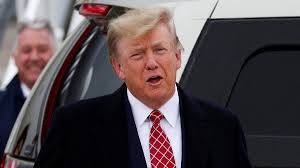Trump admin considers temporary tariff plan of up to 15% for 150 days: Report

The Trump administration is reportedly exploring a temporary tariff plan that would impose duties of up to 15% on a broad range of imported goods for a duration of 150 days. This move comes as the administration faces mounting legal challenges to its existing tariff policies, prompting officials to seek alternative approaches that could sustain their trade agenda while complying with legal requirements.
Background: Legal Setbacks to Trump’s Tariff Strategy
Over the past few years, the Trump administration pursued an aggressive tariff policy aimed at protecting U.S. industries and addressing trade imbalances. These tariffs, levied on hundreds of billions of dollars’ worth of imports from countries such as China, the European Union, and others, were justified under the International Emergency Economic Powers Act (IEEPA). The administration argued that these tariffs were necessary to counter national security threats and unfair trade practices.
However, in a significant legal setback, the U.S. Court of International Trade ruled on May 28, 2025, that President Trump’s broad tariffs under the IEEPA exceeded presidential authority. The court found that the tariffs were imposed without sufficient congressional approval and were not directly related to any declared national emergency, thereby deeming them unlawful. Consequently, a nationwide injunction blocked the enforcement of these tariffs, creating uncertainty for businesses and markets dependent on them.
The Appeal and Temporary Reinstatement
The administration quickly responded by appealing the court’s ruling. On May 29, a federal appeals court granted a temporary stay, allowing the tariffs to remain in effect while the appeal process continues. This legal back-and-forth underscores the precarious nature of the current tariff regime and the administration’s determination to uphold its trade policies despite judicial opposition.
The Proposed Temporary Tariff Plan
In light of these developments, the Trump administration is considering invoking Section 122 of the Trade Act of 1974 as an alternative legal foundation for imposing tariffs. Unlike the IEEPA, Section 122 empowers the president to enact temporary tariffs—often referred to as “safeguard measures”—to protect domestic industries from sudden surges in imports that cause serious injury.
Under the proposed plan, tariffs of up to 15% could be levied on a wide range of imports for a period of 150 days. This interim measure would provide a stopgap solution, allowing the administration to maintain pressure on trading partners while it navigates ongoing legal challenges and potentially crafts more permanent tariff policies.
Potential Impact on Trade and Industry
If implemented, this temporary tariff plan could affect numerous sectors, including manufacturing, agriculture, and retail. Industries reliant on imported components or finished goods may face increased costs, which could be passed on to consumers through higher prices. At the same time, domestic producers may benefit from reduced foreign competition, potentially leading to increased production and job growth in certain sectors.
The move could also have ripple effects on global trade relations. Countries targeted by the tariffs may retaliate with their own duties on U.S. exports, escalating trade tensions. Moreover, ongoing trade negotiations with key partners could become more complex as parties assess the impact of the temporary tariffs.
Strategic Considerations and Political Implications
The administration’s consideration of the 15% tariff for 150 days reflects a strategic pivot in response to legal constraints. By using an existing trade law with clearer congressional backing, the government hopes to fortify its position and avoid future court rulings that undermine its tariff actions.
Politically, this approach allows the administration to signal resolve in protecting American industries and workers while demonstrating a willingness to adapt its methods within the bounds of the law. It also provides a limited timeframe, which could ease concerns among domestic businesses about the uncertainty of prolonged tariff disruptions.
Challenges Ahead
Despite its potential advantages, the temporary tariff plan is not without challenges. The 150-day limit means that the administration will need to act swiftly to negotiate trade agreements or develop more sustainable policies. Additionally, Congress and industry stakeholders may scrutinize the plan closely, raising questions about its scope, targets, and economic impact.
Internationally, affected countries may seek recourse through the World Trade Organization (WTO) or pursue diplomatic channels to oppose the tariffs. The risk of trade retaliation could escalate, potentially affecting U.S. exporters and leading to broader economic consequences.
Conclusion
The Trump administration’s consideration of a temporary 15% tariff plan lasting 150 days represents a pragmatic response to recent legal hurdles faced by its broader tariff strategy. By leveraging Section 122 of the Trade Act of 1974, the government aims to maintain leverage in trade disputes while complying with judicial rulings.
This interim solution underscores the complexities of trade policy in a highly interconnected global economy and highlights the delicate balance between protecting domestic interests and adhering to legal frameworks. As the situation develops, businesses, policymakers, and international partners will be watching closely to see how this temporary tariff plan shapes the future of U.S. trade relations.






